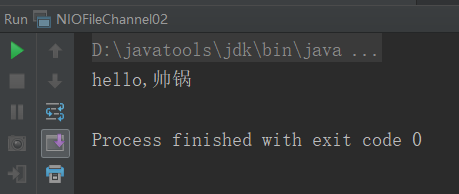标签:输入流 puts bytes new netty 通过 array buffer length
public class NIOFileChannel01 { public static void main(String[] args) throws Exception { String str = "hello,帅锅"; //创建一个输出流->channel FileOutputStream fileOutputStream = new FileOutputStream("d:\\file01.txt"); //通过 fileOutputStream 获取 对应的 FileChannel //这个 fileChannel 真实 类型是 FileChannelImpl FileChannel fileChannel = fileOutputStream.getChannel(); //创建一个缓冲区 ByteBuffer ByteBuffer byteBuffer = ByteBuffer.allocate(1024); //将 str 放入 byteBuffer byteBuffer.put(str.getBytes()); //对byteBuffer 进行flip byteBuffer.flip(); //将byteBuffer 数据写入到 fileChannel fileChannel.write(byteBuffer); fileOutputStream.close(); } }
public class NIOFileChannel02 { public static void main(String[] args) throws Exception { //创建文件的输入流 File file = new File("d:\\file01.txt"); FileInputStream fileInputStream = new FileInputStream(file); //通过fileInputStream 获取对应的FileChannel -> 实际类型 FileChannelImpl FileChannel fileChannel = fileInputStream.getChannel(); //创建缓冲区 ByteBuffer byteBuffer = ByteBuffer.allocate((int) file.length()); //将 通道的数据读入到Buffer fileChannel.read(byteBuffer); //将byteBuffer 的 字节数据 转成String System.out.println(new String(byteBuffer.array())); fileInputStream.close(); } }

标签:输入流 puts bytes new netty 通过 array buffer length
原文地址:https://www.cnblogs.com/liuyi13535496566/p/14396718.html